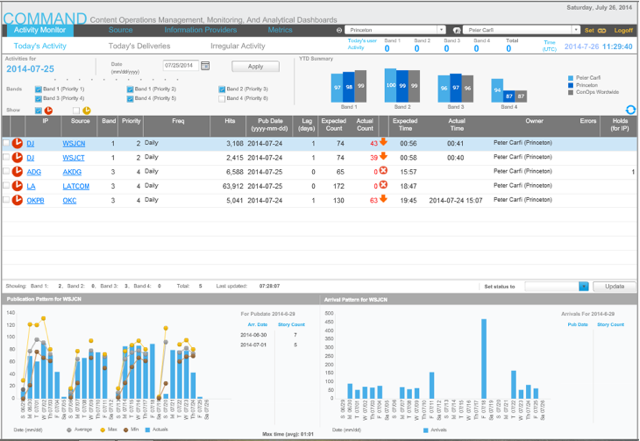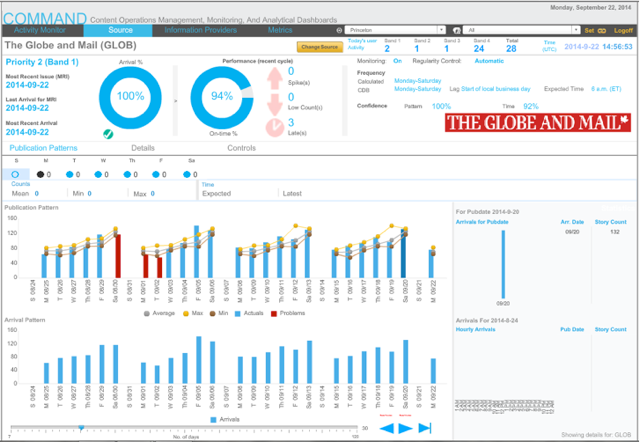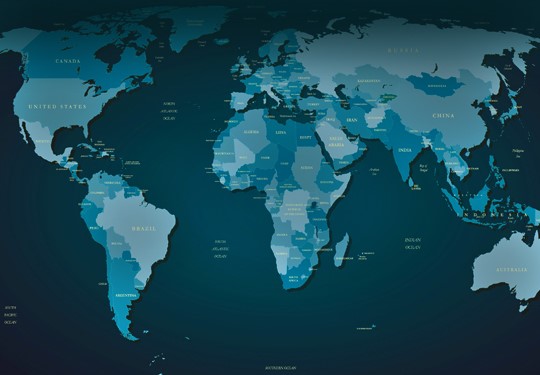A leading publishing and financial information company purchases more than 34,000 externally licensed publications, datasets, and other research sources from information providers around the globe to support its own products and services.
The company’s Content Operations Group is responsible for monitoring electronic content deliveries from the information providers. It runs three operations centers around the world that enable it to monitor electronic content arrivals 24 hours a day. Content Operations is responsible for working with the individual publishers and content aggregators when content shipments are late, not received, or when other problems occur, such as too few articles or file formatting issues.
Over the last several years, the number of licensed content sources has grown significantly while the staffing levels in Content Operations has remained flat. The Group had been monitoring the sources manually by querying the underlying databases as much as eight times per day for each source—a labor-intensive and time-consuming activity. By early 2013, Content Operations found that they were actively monitoring less than 10 percent of their licensed content sources. Customer complaints increased because published articles from sources not being actively monitored were missing from across the company’s various product lines.
The Vice President of Content Operations was dissatisfied with the high level of customer complaints. She couldn’t hire more personnel so she sought an automated monitoring, alerting, and dashboard system that would enable the Group to monitor 100 percent of licensed publications. “We envision deploying a set of online, electronic dashboards that will allow Content Operations to get an accurate assessment of content delivery timeliness and missing deliveries. The dashboards will provide ‘near real time’ coverage for all our information providers.”
Iknow was selected to design, develop, and deploy the new system. Iknow had extensive experience delivering business intelligence solutions, familiarity with many BI commercial software products, and detailed knowledge of the company’s technical infrastructure, which was gained from previous projects.
Iknow conducted requirements sessions to identify and document the system’s desired functionality. Key system capabilities included:
- Real-time monitoring of content deliveries and article counts.
- Dynamic alarm methodology based on the historical publication and delivery patterns for each source.
- Multiple views of the data for reporting at the individual staff level, center level, and Group level.
- Predictive analysis.
Iknow prepared a business requirements document that included detailed written descriptions of the functionality of every proposed dashboard. The requirements document also included detailed wire frames that illustrated how the data would be displayed on each dashboard.
Iknow designed and implemented the following alerting logic:
- Pattern discovery for historical content. Iknow analyzed the historical data for content arrivals and developed algorithms for determining the “best fit” patterns. More than 775 patterns were identified and assigned to the content sources. Patterns were grouped into “day of the week” patterns (e.g., Monday/Wednesday/Friday); “calendar date” patterns (e.g., arrivals occurred on the 5th and 20th days of every month); and “longer period” patterns (e.g., quarterly or semiannually). The average arrival times, article quantities for each delivery date, statistical metrics (e.g., standard deviations), and altering thresholds were also calculated from the historical data.
- Delivery expectations for a specific date. Iknow developed an expected delivery calculation engine that generates a list of the expected content deliveries for a given date. The engine uses the identified arrival pattern for each source and creates a list of the expected arrivals.
- Alerting. Iknow developed a real-time alerting engine that notifies a Content Operations Specialist when an individual content delivery assigned to him or her falls outside of one or more of its expected thresholds. Specifically, the system monitors each content delivery expected on that date and creates alerts for lateness (which includes missing deliveries), quantity deviations that fall outside of the high- and low-volume thresholds, and other types of delivery problems.
The historical delivery patterns for each source are updated daily. The expected deliveries for the next day are calculated late in the day on the previous day. The alerting engine compares expected deliveries with actual deliveries every 1 to 2 minutes.
Iknow performed the following tasks:
- Conducted multiple requirements gathering sessions with Content Operations personnel.
- Developed Content Operations-specific use cases.
- Identified and cataloged the source data elements.
- Defined the calculated variables.
- Developed and refined the statistical methodology for calculating late content deliveries.
- Developed the monitoring and alerting logic.
- Developed sketches, wire frames, and mockups of dashboard designs.
- Architected, designed, and built the BI universe.
- Architected, designed, and built the new database and database applications.
- Architected, designed, and built the 12 dashboards.
- Conducted user acceptance testing and refined the dashboards based on user feedback.
- Prepared a user guide.
- Conducted end-user training.
The monitoring and alerting system was implemented using SAP BusinessObjects Business Intelligence (BI) Platform and Microsoft SQL Server. The primary products used from the SAP BI Platform were Dashboards, Web Intelligence, and Universe. The core features deployed were reporting, interactive analysis, dashboards and visualization, data exploration, and advanced analytics.
The new system was deployed on a virtual private cloud (VPC) environment, hosted at Amazon Web Services, and custom data and application integration was implemented between AWS and the company’s secure data centers. SQL Server Integration Services (SSIS) was used to perform data extraction, transformation, and load (ETL) steps.
Iknow’s primary deliverable was the design and development of customized dashboards for Content Operations end users, including the underlying solution logic, algorithms, and databases. Other deliverables included installing, configuring, and testing the SAP Business Intelligence Platform, integrating the new system with the company’s existing databases and applications, preparing the user guide, and delivering end-user training.
Two screen shots from the system are presented below. The first screen shot shows the late and missing content deliveries based on their expected arrival times.
Today's Activitiy Dashboard

The second screen shot shows the actual delivery performance for a specific source.
Source Detail Dashboard

The global media company has a monitoring and alerting system that provides real-time information about the delivery status of thousands of externally licensed publications, datasets, and other content sources. Content operations specialists now spend their time working with information providers on resolving content delivery problems because manual monitoring of content deliveries is no longer necessary. Customer satisfaction metrics have increased because there are less gaps in content coverage.


